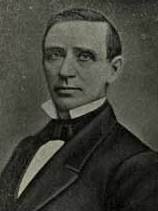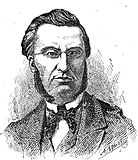After statehood was achieved September 9, 1850 until 1865, California elected its representatives statewide at-large — two representatives from September 11, 1850 to 1861, and 3 representatives from 1861 to 1865.
The 1863 United States Senate election in New York was held on February 3, 1863, by the New York State Legislature to elect a U.S. Senator to represent the State of New York in the United States Senate.
This is a list of members of the New South Wales Legislative Assembly from 1860 to 1864:
The United States Senate elections of 1862 and 1863 were elections during the American Civil War in which Republicans increased their control of the U.S. Senate. The Republican Party gained three seats, bringing their majority to 66% of the body. Also caucusing with them were Unionists and Unconditional Unionists. As many Southern states seceded in 1860 and 1861, and members left the Senate to join the Confederacy, or were expelled for supporting the rebellion, seats were declared vacant. To establish a quorum with fewer members, a lower total seat number was taken into account.

The 1863 United States Senate election in Pennsylvania was held on January 13, 1863. Charles Buckalew was elected by the Pennsylvania General Assembly to the United States Senate.
The 1863 Kaiapoi by-election was a by-election held on 2 September 1863 in the Kaiapoi electorate during the 3rd New Zealand Parliament.

This is a list of members of the Victorian Legislative Council from the elections of 1 September – 2 October 1862 to the elections of 2 September – 3 October 1864.

The 1863 California gubernatorial election was held on September 2, 1863 to elect the governor of California. Former governor John G. Downey was unsuccessful in his bid for reelection to a second, non-consecutive term, losing to former United States Representative Frederick Low.

The 1863 Minnesota gubernatorial election was held on July 10, 1863 to elect the governor of Minnesota.
Elections to Liverpool Town Council were held on Monday 2 November 1863. One third of the council seats were up for election, the term of office of each councillor being three years.
Elections to Liverpool Town Council were held on Wednesday 1 November 1862. One third of the council seats were up for election, the term of office of each councillor being three years.
The 1863 Town of New Plymouth by-election was a by-election held on 9 October in the Town of New Plymouth electorate during the 3rd New Zealand Parliament.
The 1863 Heathcote by-election was a by-election held on 28 October in the Heathcote electorate during the 3rd New Zealand Parliament.
The Dunedin and Suburbs North by-election 1863 was a by-election held on 3 September 1863 in the Dunedin and Suburbs North electorate during the 3rd New Zealand Parliament.
The 1873 Suburbs of Nelson by-election was a by-election held on 14 May 1873 in the Suburbs of Nelson electorate in Nelson during the 5th New Zealand Parliament.
The 1863 Hampden by-election was a by-election held on 2 July 1863 in the Hampden electorate during the 3rd New Zealand Parliament.
The 1863 Dunedin and Suburbs South by-election was a by-election held on 20 June 1876 in the Dunedin and Suburbs South electorate during the 3rd New Zealand Parliament. It was then a two-member electorate; the other member being William Hunter Reynolds.

In the Chicago mayoral election of 1863 Democrat Francis Cornwall Sherman won reelection, defeating National Union (Republican) nominee Thomas B. Bryan by an extremely narrow quarter percent margin.
The 1863 Akaroa by-election was a by-election held on 30 October 1863 during the 3rd New Zealand Parliament in the Canterbury electorate of Akaroa.









